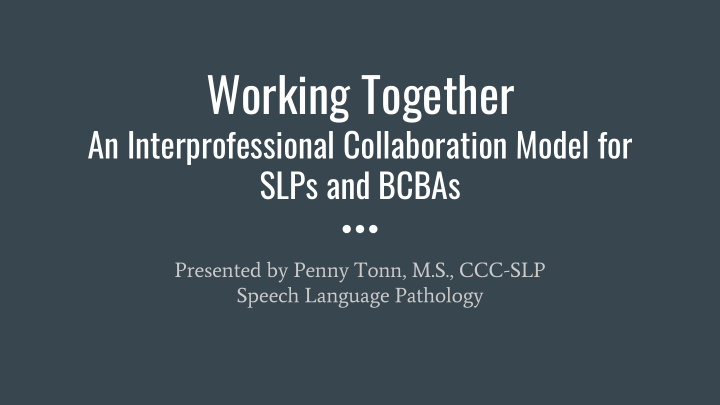



Working Together An Interprofessional Collaboration Model for SLPs and BCBAs Presented by Penny Tonn, M.S., CCC-SLP Speech Language Pathology
SLPs Provide de treatment atment for speech, ch, languag uage, e, ● social al communic unicati ation, on, liter erac acy, y, Theoretical feedi ding/ ng/sw swall llowing owing, and/o /or r AAC AC Use linguistic uistic, behavi aviora oral, l, ● Background develo lopm pmen ental, l, cognitive tive, , and social al theore oreti tica cal l backg ckgrounds rounds to treat at communic unicati ation on deficits ts Treatment of Communication BCBAs As Differences Provide de inter erven entio tion n to affec ect t a v variet ety ● of sociall lly y significa cant nt behav aviors rs for Use behav avioral ral theo eori ries es to manipul pulate ate ● Autism Spectrum Disorder environme ronmental ntal variable ables s to reduce uce or incre rease ase behav aviors rs
Scope of Practice SLP ABA
Effecting Change in Interprofessional Practices/Education (IPP/IPE) What is needed to change the current climate of collaboration between SLPs and BCBAs? Clarifying roles and scopes ● Improving training in collaborative practices ● Regulatory changes in IPP ● Organizational changes in IPP ● Improve Change barriers Implement Identify what is Healthcare within the effective needed systems practices Outcomes Musaji, I., Self, T., Marble-Flint, K., & Kanade, A. (2018).
A New Model for Collaboration: Using the context of Day Treatment Facilitators Barriers Effective communication Scheduling and time conflicts Promoting team dynamics through leadership Unclear roles and responsibilities Transparent expectations Differences in theoretical backgrounds Conflict resolution strategies Poor communication between stakeholders Newton, P., Halcomb, E., Davidson., P., Denniss, A. (2007).
Day Treatment Provider Handbook
Organi nizational l Goals Clearer delineation on conflict ● resolution for SLP and BCBA Training on collaboration with ● families/caregivers Future Directions Increase awareness of cultural and ● linguistic differences Facilitate consultation and/or ● referrals to specialty providers Conduct training on parent ● coaching strategies Develop patient satisfaction ● measurement
Broader r Interpro rofessi essional al Practice ce Goals Improved IPP training for ● professionals and families Future Directions Clearly defined scope of practices ● Advocacy for funding processes to ● support collaborative practices Emphasis on accessing families ● and individuals with developmental disabilities as collaborative partners
Interprofessional Education Collaborative, 2016
Acknowledgements I would like to extend my deepest gratitude to my colleagues at Northwest ABA and ABLE Health who have openly engaged in the development of a collaborative model. A sincere thank you to the University of Washington LEND faculty and mentors, community mentors, and fellow LEND trainees who have supported and facilitated my growth as a leader and professional throughout the LEND experience. The utmost gratitude is due to Dr. Laura Snow, my LEND mentor, who has helped me refine my approaches to leadership and facilitated expansive opportunities to improve collaborative services within our communities.
References American Speech-Language-Hearing Association (2016). Scope of Practice in Speech-Language Pathology. Retrieved from www.asha.org/policy Cardon, T. (2017). Speech-language pathologists and behavior analysts: Perspectives regarding theories and treatment of autism spectrum disorder. Perspectives of the ASHA Special Interest Groups SIG 1 , 2(1), 27-46. Donaldson, A. & Stahmer, A. (2014). Team collaboration: The use of behavior principles for serving students with ASD. Language, Speech, and Hearing Services in Schools , 45, 261-276. Interprofessional Education Collaborative (2020). Interprofessional education collaborative. Retrieved from https://www.ipecollaborative.org/about-ipec.html Gerdts, J., Mancini, J., Fox, E., Rhoads, C., Ward, T., Easley, E., & Bernier, R. (2018). Interdisciplinary team evaluation: An effective method for the diagnostic assessment of autism spectrum disorder. Journal of Developmental & Behavioral Pediatrics , 39(4), 271-281. Kelly, A., & Tincani, M. (2013). Collaborative training and practice among applied behavior analysts who support individuals with autism spectrum disorder. Education and Training in Autism and Developmental Disabilities , 48(1), 120-131. Lemieux-Charles, L., & McGuire, W. (2006). What do we know about health care team effectiveness? A review of the literature. Medical Care Research and Review, 63, 263-300. Manlapaz, N. (2018). Speech-language pathologists and behavior analysis: How is collaboration viewed among their professions. California State University, ProQuest Dissertations Publishing. 10784372. Musaji, I., Self, T., Marble-Flint, K., & Kanade, A. (2018). Moving from interprofessional education toward interprofessional practice: Bridging the translation gap. Perspective of the ASHA Special Interest Groups , 4(5), 971-976. Nalitz, N. (1992). Consultation and collaboration programs for individuals with Autism. Clinics in Communication Disorders , 31(1), 31-43. Newton, P., Halcomb, E., Davidson., P., Denniss, A. (2007). Barriers and facilitators to the implementation of the collaborative method: reflections from a single site. Qual Saf Health Care , 16(6), 409‐414. Pfeiffer, D., Pavelko, S., Hahs-Vaughn, D., & Dudding, C. (2019). A national survey of speech- language pathologists’ engagement in interprofessional collaborative practice in schools: Identifying predictive factors and barriers to implementation. Language, Speech, and Hearing Services in Schools , 50, 639-655. Schroeder, E., Lynch, K., & Turgeon, A. (2017). Strategies for effective collaboration among multidisciplinary teams: Integration of an ABA professional. S chool of Occupational Master’s Capstone Projects. University of Puget Sound. Tallia, A., Lanham, H., McDaniel, R., & Crabtree, B. (2006). 7 characteristics of successful work relationships. Family Practice Management, 13, 47-50. Zraick, R., Harten., A.C., & Hagstrom, F. (2014). Interprofessional education and practice: A primer for training future clinicians. Perspectives on Issues in Higher Education , 17(2), 39-46.
Recommend
More recommend